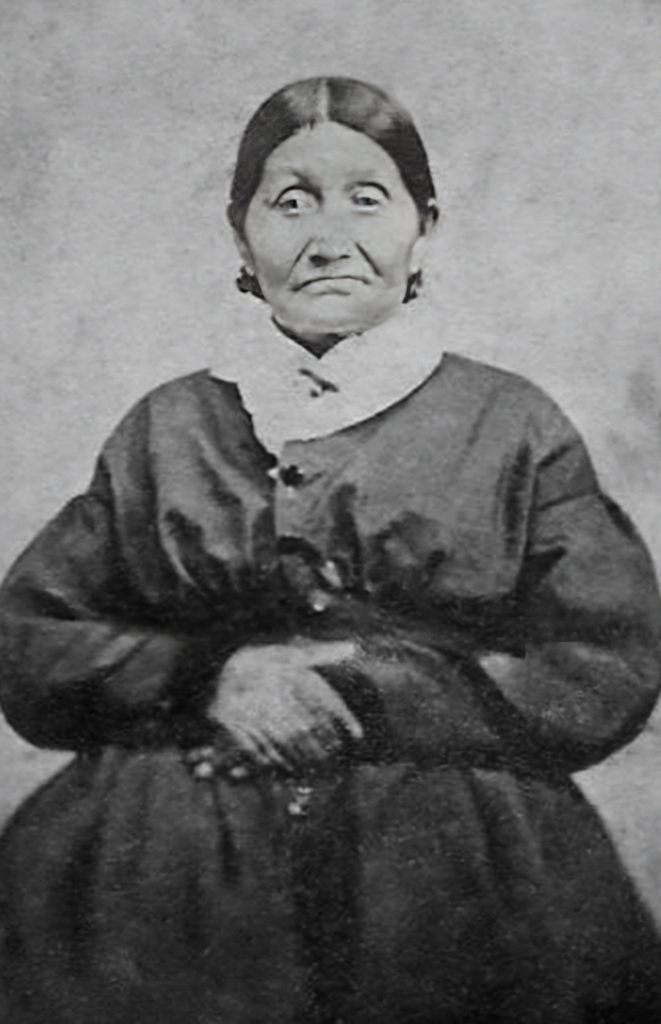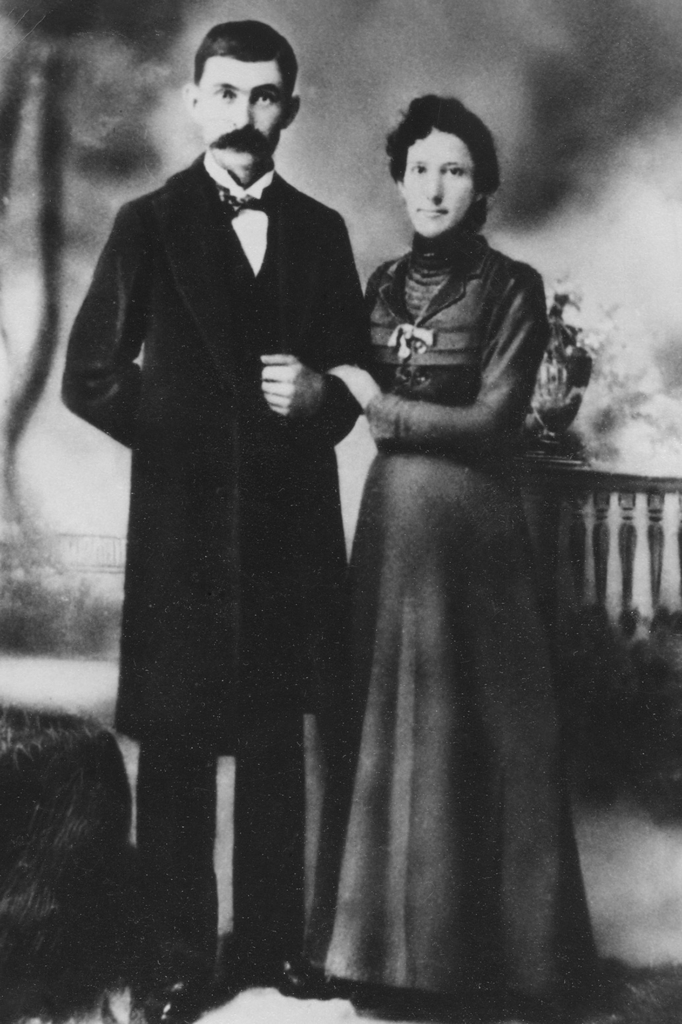The Citizen Potawatomi Nation’s Cultural Heritage Center provides resources to keep the Tribe’s history safe and accessible for generations to come. One key way the Nation does this is through the CHC’s archives and video interviews.
To highlight some of the archive’s holdings, the Hownikan is featuring photographs and family history of every founding Citizen Potawatomi family. If interested in assisting preservation efforts by providing copies of Citizen Potawatomi family photographs, documents and more, and to schedule family interviews, please contact the CHC at 405-878-5830.
Note: This article will discuss the Melott family history. A separate article is planned for the Melot family.
Family’s beginnings
The Melott family history begins with a French immigrant named Joseph Melot. Joseph married Catherine (Katy) Bergeron, the daughter of Francois Xavier Bergeron and Wat-che-kee (sometimes spelled Watseka), or Josette Bergeron.
When the Potawatomi were forced out of their Iowa lands in 1846 by the Council Bluffs Treaty, they removed to a reservation of 567,000 acres in Kansas. The tribal roll of 1863, published by the Riley County, Kansas, Genealogical Society, lists both Francois and Josette Bergeron, both age 44, as residents of the Potawatomi Reservation at St. Marys, Kansas. Together, they had Jean (John) Batiste, Catherine (Katy), Matilda and Charles.

When Wat-che-kee died in 1875, she was buried in an unmarked grave just southwest of the present-day site of the Wanette Cemetery in Indian Territory. Her husband, Francois, died in 1881 and was buried in the Wanette Cemetery.
It was their daughter, Catherine “Katy” and her husband, Joseph Melot, who established the town of Wanette in Indian Territory, prior to Oklahoma statehood in 1907.
Founding of Wanette
In Kansas, settlers and railroad companies began pressuring the U.S. government to open land for settlement. The Potawatomi, displaced from their ancestral homelands, were now being forced from their adopted home in Kansas. Some of the Kansas Potawatomi decided to take individual allotments in Indian Territory. Katy Melot was among those who elected to receive an allotment.
A Shawnee News-Star article in the CHC archives recounts the history of Wanette, Indian Territory. The town was founded March 19, 1894, by Joseph and Katy (Bergeron) Melot. The couple owned 240 acres on which the first townsite was built.
Katy (Bergeron) Melot was born in July 1851 in Kansas. Joseph T. Melot was born in France on Aug. 15, 1839. Katy and Joseph were the parents of Joseph Edward (J.E.), William Warren (W.W.), Joseph Thomas (Tom), Lewis (Louis), Elmer, Earl, Ruth, Grace, Leander (Lee) and Benjamin.
The family moved from Iowa to Kansas in 1863 before eventually settling in Wanette in 1868. A 1970 news article within the CHC archives stated the oldest existing log cabin in Pottawatomie County at the time had been built by Joe Melot. The cabin was originally built as a two-story structure but later was reduced to one and a half story. At the time of publication in 1970, the article said the cabin was being used for hay storage while cattle grazed nearby.

Three years after establishing his home site, Joe returned to Kansas and helped six other families move to Oklahoma Territory in 1871. They traveled in a wagon train of 14 covered wagons.
The first Catholic mass held in the county took place at the Melot cabin, conducted by Fr. Isidor Robot shortly after Robot arrived in January 1876. That year, a council led by Peter the Great approved the plan for Joe and Katy to grant some land to the Benedictine Order of the Catholic Church to establish a mission. Robot established Sacred Heart Mission, where many Potawatomi youth were educated.
The town was also known by other early names, such as Oberlin, Isabella, Clardyville and Wagoza, before finally settling upon Wanette. It is believed that the post office was opened on March 19, 1894.
However, the 1903 construction of the Santa Fe Railroad meant that the town would have to be relocated one mile north to its present-day location so the townspeople would have access to the railroad. The town prospered following the move, boasting of successful cotton gins, hardware stores, banks, a brick kiln and saloon. Soon a school was built, and more people flocked to the burgeoning town.
Joseph died in 1898 and was buried in the Wanette Cemetery. Katy died in 1933 and was also buried in the Wanette Cemetery. Some of Joseph and Katy’s children, such as Leander, Joseph, Lewis and William, began spelling their last name as Melott.
Katy and Joseph’s daughter, Theresa, married Alexander Upton. They had three children, named Josephus, Emery and Marie. Sadly, two of their children, Bonny and Theresa, died young.
Joseph and Katy’s son, Leander (Lee) Melott, was born in Wanette on April 15, 1880. He received an 80-acre allotment in present-day Pottawatomie County. In 1900, he married Nina Lucille Johnson, and together they had Minnie Ester, Raymond Verble, Violet May (Page) and Pearl Haze. Leander died Jan. 2, 1958, and was buried in Wheatland, Oklahoma.
Joseph and Katy’s son, Joseph Thomas (Tom) Melott and his wife, Margaret Jane Lambert, were the parents of Glatis M. (Melott) (Johnson) Brown. She had a son named James Earl Johnson. James and his wife, Alice Brenda (Willis) Johnson, had a son named Dennis Erin Johnson. Tom Melott also had a daughter named Marjorie (Melot) (Sinor) Bailey. She had a daughter named Barbara A. (Bailey) Montgomery and a son named Denzil Woodfer Bailey, Jr.
Joseph and Katy’s son Tom was also the father of Floyd E. Melott, Marion X. Melot, Sr., Milton, Milford Glen, Joseph Aaron and George Benton. Marion, Sr. was the father of Marion X. Melot, Jr.
Katy and Joseph’s son Lewis (Louis) was the father of Benjamin Lewis, Lou Belle (Hash), Theresia Cardila (Mitchell), Lee Haskell, Katherine “Katie” (Ferri), Viola Lena (Burrow), Emily Rudetha (Smith), Thelma Gustavia (Highland), Joseph David and Mary Ruth (Bledsoe). One CHC document stated that in 1970 Louis was 90 years old and still walked to town several times a day. He attended Sacred Heart School as a boy but later served many years as a Baptist and Methodist minister.
Katy and Joseph’s son William was the father of Frank T. Melott and Ernest R. Melott. Frank’s son was Roger Kenneth. Ernest’s son was Teddy B. Melott.
Early life in Oklahoma
The Melott family are among the earliest contributors to what would eventually become the state of Oklahoma. Life in Indian Territory was anything but easy. All infrastructure had to be built by hand, carved out from empty prairies. In some instances, Melott family members did leave Oklahoma to find stability.
An interview with Letha Melott Tacker published in 1983 revealed that she had two brothers and two sisters. Letha was born in 1903 in Wanette to William Warren Melott and Myrtle Melott.
The children grew up near Wanette but moved frequently to allow their father to find work. In 1911, they moved to Oregon, where their youngest sister was born in Prenore. Their father found work in a sawmill.
They returned to Oklahoma after about a year, settling near Trousdale. There, the children helped their uncle on his family farm. They returned to Wanette, where Letha attended school until the fourth grade.
Then the family moved to Cushing. Their father had found work in the oil field, and their mother ran a cook shack. Eventually, the family found a home in Shawnee on East Main Street. The children attended nearby Franklin School.
In 1918, Letha noted that she had turned 15 and recalled that World War I had begun, and she was scared her boyfriend Carter Tacker would have to go overseas to support the war effort. They married on Oct. 14, 1918, but fortunately, Carter was not deployed.
Then, the Great Influenza pandemic of 1918 was the world’s greatest concern. Letha and her husband Carter were married for only 10 weeks when both came down with the disease. She was sick for 10 days; her husband for two weeks. He later developed double pneumonia. Letha and her mother sat up all night, applying the homemade remedy of turpentine, grease and camphor. Her husband recovered the next morning.
Letha said her husband began working at a lumberyard until 1928 when the Great Depression hit. Businesses, including the lumberyard, failed. They traded their home in town for a farm where they could raise their own food.
It was through the courage to take allotments and face the unknown in Indian Territory that the Melott family came to prosper. With their hard work and perseverance through unimaginable hardship, they put down roots that allowed the family to thrive, and in turn, the southern half of Pottawatomie County was able to flourish.
If interested in assisting preservation efforts by providing copies of Citizen Potawatomi family photographs, documents and more, and to schedule family interviews, please contact the CHC at 405-878-5830. Schedule interviews online at portal.potawatomi.org. Learn more about the Family Reunion Festival at cpn.news/festival, and find research resources online at potawatomiheritage.com.
